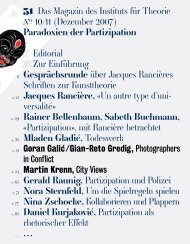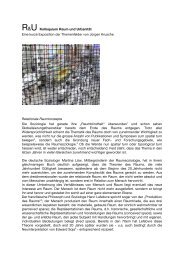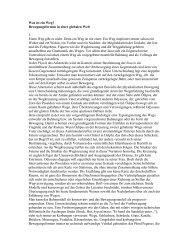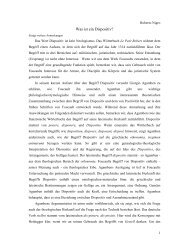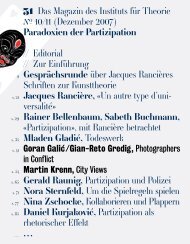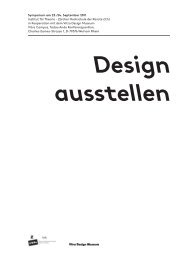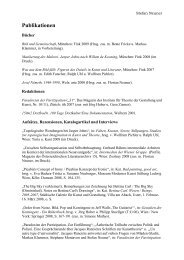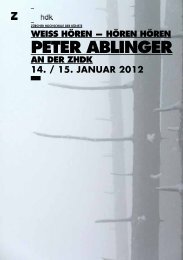Heft - Institut für Theorie ith
Heft - Institut für Theorie ith
Heft - Institut für Theorie ith
Erfolgreiche ePaper selbst erstellen
Machen Sie aus Ihren PDF Publikationen ein blätterbares Flipbook mit unserer einzigartigen Google optimierten e-Paper Software.
31 N°- 14/15<br />
The Figure of Two<br />
Alenka Zupančič<br />
The<br />
Double<br />
and Its<br />
Relationship<br />
to the<br />
Real<br />
There is a very singular and undoubtedly<br />
very fascinating figure of the Two,<br />
which has – among di≠erent figures of<br />
the Two – a rather distinguished status,<br />
due to the important role it has played<br />
in art, especially in literature. This is the<br />
figure of the double and, more broadly<br />
speaking, of redoubling. In the following<br />
discussion of this figure I will not<br />
speak so much about its history and its<br />
articulations in literature, but will rather<br />
focus on its fundamental structure<br />
and its philosophical implications. In<br />
order to do this, I will engage in a dialog<br />
w<strong>ith</strong> an author who has dedicated most<br />
of his philosophical work to this topic,<br />
albeit from a very specific critical perspective.<br />
The author is Clément Rosset,<br />
a very interesting figure of contemporary<br />
French philosophy, although (and<br />
strangely) not so well known and translated<br />
outside France. I will be arguing<br />
as much w<strong>ith</strong> Rosset as against him; for,<br />
several irreconcilable di≠erences notw<strong>ith</strong>standing,<br />
Rosset develops many<br />
things which, in my conceptual space<br />
(strongly curbed by the Lacanian theory),<br />
resonate in a surprising way which<br />
can be very productive to engage w<strong>ith</strong>.<br />
To begin w<strong>ith</strong> we could say that<br />
the double is not exactly a one, yet it also<br />
does not constitute a two in the ordinary<br />
sense of the term. It seems to be ne<strong>ith</strong>er one, nor two.<br />
Two identical bottles of beer are not doubles, as far as there is<br />
place for both in the reality of, say, our refrigerator. And if we<br />
think of it, the notion of a double presupposes not so much<br />
the sameness of appearance or manifestation, as the sameness<br />
of the time and place. The figure of the double involves<br />
a duality or a two that compete for the same time and place<br />
or simply for the same reality as structured by time and<br />
space (for in reality, there is never place / time for both). It<br />
seems that – to take the example of the entities called people<br />
– we do not simply inhabit a certain place and move in space,<br />
but also, and on a more fundamental level, carry our place<br />
w<strong>ith</strong> us wherever we go. Even if we appear somewhere as<br />
completely out of place, or at an utterly wrong time, we still<br />
seem to be “ourselves” ontologically speaking – we are out of<br />
place in relation to some symbolic configuration, but it<br />
seems that we can never be out of place in the real; in the real<br />
we are always at our place (and time), which is finally our<br />
(only) real. At this level, we are e<strong>ith</strong>er at our place, or else we<br />
are not at all (we have no being). The double is precisely<br />
what is threatening at this very ontological level, for it introduces<br />
an “impossible” split into the very homogeneity of this<br />
real, that is into the very homogeneity of being and its “taking<br />
place.” We can get a good grip of what this means in the<br />
following aphorism by Stanislaw Jerzy Lec, a famous Polish<br />
aphorist: “Who knows what Columbus might have discovered<br />
had America not blocked his way!” This suggestion of a<br />
double is a very ingenious one, for it suggests that reality<br />
itself is the double which has most literally usurped (blocked)<br />
the place of something else.<br />
So, if the figure of the double implies something more<br />
than one, it also implies something less than two: it is not about<br />
two constituted ontological entities, but rather something<br />
that induces a doubt into the (original) one as<br />
ontological entity. Rosset is very right in pointing<br />
out this characteristic of the double. He reverses<br />
the standard diagnosis of Otto Rank who linked<br />
the anxiety in the face of a double to our primordial<br />
fear of death. We usually consider the reality<br />
of the double to be “better” than ours – and in this<br />
sense it can indeed seem that the double represents<br />
an immortal instance in relation to the subject<br />
(which is Rank’s thesis). However, the real<br />
source of our anxiety is not simply our future<br />
death, but above all our (present) non-reality and<br />
non-existence. It would not be so hard to die if we<br />
knew for sure that we have at least lived; but it is<br />
precisely this life, as perishable as it is, that the<br />
subject starts to doubt in the cases of “split personality”<br />
or appearing of a double. In the ill-fated<br />
couple in which I am united w<strong>ith</strong> a phantom other,<br />
the real is not on my side, but rather on the side<br />
of the phantom: it is not the other that redoubles<br />
me, it is rather that I am the other’s double. 1 In<br />
short, when my double appears, my present existence<br />
(my being as such) appears as utmost uncertain.<br />
Hence, and to repeat: the figure of the double<br />
it is not about two constituted ontological entities,<br />
but rather something that induces a doubt in the<br />
(original) one as ontological entity.<br />
Let this su∞ce as introduction, and let us<br />
now first look more closely at Rosset and his arguments.<br />
Rosset dedicated most of his philosophical<br />
work to the theme best encapsulated in the title of<br />
his central book Le réel et son double. In it, he<br />
develops his arguments around the following fundamental<br />
observation: the real always tends to<br />
strike us as impossible to tolerate in some way –<br />
too cruel and disagreeable, or else too simple and<br />
idiotic. In our general relationship to the real he<br />
thus recognizes an attitude that betrays both anxiety<br />
and contempt (disregard): anxiety as to the<br />
fact that the real is really only just what it is, and<br />
the coextensive contempt for the real in its “idiotic”<br />
simplicity and plainness. Hence a whole<br />
number of strategies that aim at circumventing<br />
the real, and replacing it w<strong>ith</strong> something else<br />
which we then declare to be the actual, true real.<br />
On the basis of numerous examples Rosset develops<br />
a lucid and often amusing analysis of these<br />
strategies, pointing at their common denominator,<br />
which is the redoubling, or duplication of the<br />
real, and the enthronement of its double.<br />
First of all I would like to suggest that the<br />
notion of the real and its redoubling that he presents<br />
via di≠erent examples and their di≠erent<br />
1 - See Clément Rosset, Le réel<br />
et son double, Paris 1984, p. 91.<br />
2 - This structure has been<br />
analyzed exemplarily by Octave<br />
Mannoni in his article “Je sais<br />
bien mais quand même,” in:<br />
Clefs pour l'Imaginaire ou l'Autre<br />
scène, Paris 1969, pp. 9–33.<br />
It is therefore quite curious that<br />
there is no reference to him in<br />
Rosset’s book.<br />
3 - All translations from French in<br />
this essay A. Z., Rosset, Le réel<br />
(note 1), pp. 21f.<br />
94



